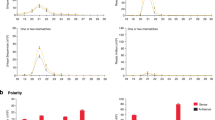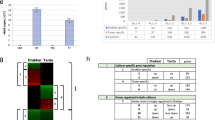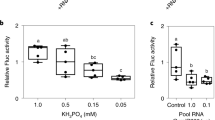Abstract
In plants and fungi, the introduction of transgenes can lead to post-transcriptional gene silencing1,2. This phenomenon, in which expression of the transgene and of endogenous genes containing sequences homologous to the transgene can be blocked, is involved in virus resistance3,4,5 and genome maintenance6,7. Transgene-induced gene silencing has been termed quelling in Neurospora crassa and co-suppression in plants. Quelling-defective (qde) mutants of N. crassa, in which transgene-induced gene silencing is impaired, have been isolated8. Here we report the cloning of qde-1, the first cellular component of the gene-silencing mechanism to be isolated, which defines a new gene family conserved among different species including plants, animals and fungi. The qde-1 gene product is similar to an RNA-dependent RNA polymerase found in the tomato9. The identification of qde-1 strongly supports models that implicate an RNA-dependent RNA polymerase in the post-transcriptional gene-silencing mechanism. The presence of qde-1 homologues in a variety of species of plants and fungi indicates that a conserved gene-silencing mechanism may exist, which could have evolved to preserve genome integrity and to protect the genome against naturally occurring transposons and viruses.
Similar content being viewed by others
Main
Post-transcriptional gene silencing (PTGS) following transgene introduction has received a great deal of attention because of its implications in both basic and applied research. A surprising feature of PTGS is that silencing is mediated by a diffusible trans -acting molecule in both plants and fungi4,10,11. Several models propose that qualitatively different RNA molecules, defined as aberrant RNAs (abRNAs), which are able to activate gene silencing, may be produced directly from transgene templates or as a consequence of endogenous gene–transgene DNA pairing12,13. The aberration in abRNA could be double strandedness14, premature termination, or other undefined features. Nevertheless, almost all models assume that short complementary RNA molecules are synthesized by specialized cellular RNA-dependent RNA polymerases (RdRPs) which use the overexpressed or aberrant RNAs as templates15,16. Such cRNA molecules could lead to the formation of double-stranded RNA and eventually to messenger RNA degradation. However, the proposed mechanisms for PTGS are all highly speculative, as no cellular components of the gene-silencing mechanism have been identified previously. To try to identify such components, we began a genetic dissection of the gene-silencing mechanism (quelling) in the fungus Neurospora crassa17,18. Using the albino-1 (al-1) gene essential for carotenoid biosynthesis19 as a simple visible reporter for gene silencing, we identified three classes of mutant (qde) which were defective in the quelling mechanism8.
To clone the qde genes, we used random insertional mutagenesis on an al-1 transgenic strain showing an albino (white) phenotype as a consequence of post-transcriptional silencing of the endogenous al-1 gene. Of 100,000 independent insertional transformants, one strain (107) showed release of gene silencing, visible as recovery of an orange wild-type phenotype. Using heterokaryon genetic analysis, we assigned the mutation in strain 107 to one of the three previously identified qde complementation groups8, indicating that strain 107 is mutated in the qde-1 gene.
To isolate qde-1, the tagging plasmid was recovered from the 107 strain by a plasmid-rescue procedure using the restriction enzyme Bgl II, which has a single restriction site within the tagging plasmid. One plasmid, pCR4, was recovered after religation of the chromosomal DNA following restriction with Bgl II (Fig. 1a). We isolated chromosomal DNA flanking the integration site using the enzymes Bgl II and Pst I, and the resulting restriction fragment was used as a probe on a N. crassa genomic cosmid library. Two positively hybridizing cosmids, 56G11 and 40H7, were introduced by a transformation experiment into strain 107 and into the ultraviolet-induced qde-1 mutant strain M7. Both cosmids complemented the two qde-1 mutants tested, restoring al-1 gene silencing and leading to a white phenotype, indicating that both cosmids contain a functional qde-1 gene. Using the same flanking DNA as a probe, two Eco RI fragments from 40H7 and 56G11 (7.9 and 10 kilobases (kb), respectively) were identified and subcloned (Fig. 1a). Both Eco RI fragments (p79E and p10E plasmids) were able to complement two independent qde-1 mutant strains, but not qde-2 and qde-3 mutants, indicating that a functional qde-1 gene is contained in the 7.9-kb Eco RI fragment. The fact that the qde-1 gene restores al-1 gene silencing in only the corresponding mutants excludes the possibly that the cloned DNA fragment can reactivate al-1 gene silencing irrespective of the qde complementation group. The 7.9-kb Eco RI fragment was further subcloned by using the Xba I site (Fig.1a), in the middle of the Eco RI fragment. Neither of the Xba I/Eco RI fragments (pSX and pDX plasmids) complemented the qde-1 mutants, indicating that the Xba I site is probably located within the qde-1 gene.
a, Two cosmids (56G11 and 40H7) that can complement qde-1 mutants. The white box in 40H7 represents sequences from the cosmid vector. A restriction map of the 7.9-kb Eco RI fragment from 40H7, containing the functional qde-1, is shown: E, Eco RI; P, Pst I; B, Bgl II. The black box represents the identified ORF within the 7.9-kb Eco RI fragment. pDX and pSX plasmids containing Xba I (X) and Eco RI (E) subcloned DNA fragments are also shown. b, Southern blot analysis of wild type (WT) and strain 107. Genomic DNA was double-digested with Bgl II and Nae I restriction enzymes. The diagram shows the DNA probe used for hybridization and the expected Bgl II/Nae I (B/N) restriction fragments. The triangle represents the integration site in strain 107 that leads to the disappearance of the 1.0-kb restriction fragment.
The region of the Eco RI fragment encompassing the putative qde-1 gene and adjacent regions was sequenced, revealing a long open reading frame (ORF) of 4,206 base pairs (bp) coding for a putative protein of 1,402 amino acids. Two results indicate that this ORF is coincident with the qde-1 gene. First, the Xba I restriction site used to subclone the Eco RI 7.9-kb fragment is located in the middle of the ORF (Fig. 1a), consistent with the result that both Xba I/Eco RI fragments fail to complement the qde-1 mutation. Second, we mapped the tagging plasmid-insertion site in strain 107 between Bgl II and Nae I restriction sites within the ORF by Southern analysis (Fig. 1b). No size changes have been detected in the surrounding regions, excluding the possibility that deletions affecting other ORFs within the Eco RI 7.9-kb region may have occurred. The qde-1 mRNA steady-state level was two-fold higher in an al-1 silenced strain than in a wild-type untransformed strain, indicating that a regulatory mechanism exists that can activate cellular components of the silencing machinery in transgenic strains.
The QDE-1 protein deduced from the nucleotide sequence is composed of 1,402 amino acids and has a relative molecular mass of 158,004: it does not contain a signal peptide or a transmembrane domain, indicating that it is likely to be an intracellular protein, and the hydropathy plot indicates that QDE-1 is a soluble protein. A BLAST search revealed that QDE-1 shares statistically significant homology with hypothetical proteins from several other organisms, including two ORFs of Caenorhabditis elegans (accession numbers Z48334 and Z78419), an ORF of Schizosaccharomyces pombe (accession number Z98553) and four ORFs of Arabidopsis thaliana (accession numbers AF080120 and AC005169 (three ORFs at the same chromosomal location). Finally, significant homology (expected value 2× 10−17) was found with the putative protein encoded by tomato cDNA (accession number Y10403). This homology does not extend over the entire protein, but is restricted to a 570-amino-acid portion defining a conserved domain (Fig. 2). Of the homologous putative proteins identified, only the tomato cDNA has been functionally characterized and shown to encode an RdRP9.
Although RdRPs have been considered to be key enzymes in PTGS, no indication of a specific involvement of these enzymes has been provided up to now. Our finding that the qde-1 gene encodes a putative protein homologous to an RdRP constitutes experimental evidence for the involvement of an RdRP in PTGS. The presence of homologous genes conserved among different and distant species such as C. elegans and S. pombe may indicate that gene-silencing mechanisms are present in a wide range of organisms. On the other hand, the presence of several paralogous RdRP genes in the same organism, as have been found in C. elegans and A. thaliana, may also indicates that these proteins have distinct specialized functions and could be involved in other cellular processes, perhaps using different RNAs as substrates. Aberrant transgenic or viral RNAs that have accumulated after transgenic or viral infection have been proposed to be the substrates of RdRPs specific for gene silencing in plants and fungi18,20. On the other hand, double-stranded RNAs have been postulated21 to serve as the RdRP template in the interference phenomenon in C. elegans, in which expression of an individual gene can be specifically reduced by microinjecting a corresponding fragment of double-stranded RNA22,23. Identification of the specific RNA substrates for RdRP will help our understanding of the PTGS mechanism and other gene-silencing phenomena. The existence of homologous RdRP genes in different species and the observation that PTGS represents a natural mechanism for protection against viruses and invading DNA24 in plants could also indicate that suchprotection mechanisms may have been conserved during evolution.
Methods
Strains, growth conditions and transformation. The N. crassa methodology and heterokaryon analysis have been described25. Spheroplasts were prepared as described26. Strain 107 was isolated as follows: an al-1 silenced strain8, 6xw, was transformed with pMXY2, which contains a benomyl-resistance β-tubulin gene that functions as a dominant selectable marker in N. crassa27. Benomyl-resistant transformants were selected and scored for carotenogenesis by visual inspection of conidial colour: wild-type specimens were orange, whereas white-to-yellow transformants indicated silencing.
Plasmids and libraries. We isolated the genomic qde-1 gene from a cosmid library of N. crassa28. The subcloning of restriction fragments from the genomic library clones was performed in the plasmid pBSK. Subsequently, the subclones were used in co-transformation experiments using pMXY2 or pES200 (bearing hygromycin resistance).
Southern and northern hybridizations. We prepared chromosomal DNA as described29, and after digestion the genomic DNA was blotted as described30. Probes were labelled by random priming (Boheringer). The RNA was electrophoresed on agarose gels, transferred onto Hybond-N membranes and probed.
DNA sequencing and analysis. We determined the nucleotide sequence of both strands of qde-1 using the Taq FS polymerase and fluorescent method, and analysed it using an automatic Applied Biosystems 373A sequencer. We analysed the nucleotide and derived amino-acid sequences using the MacMolly Tetra program. Protein comparisons were made with BLASTP searches. ClustalW algorithm was used for the alignment.
References
Flavell, R. B. Inactivation of gene expression in plants as a consequence of specific sequence duplication. Proc. Natl Acad. Sci. USA 91, 3490–3496 (1994).
Depicker, A. & Van Montagu, M. Post-transcriptional gene silencing in plants. Curr. Opin. Cell Biol. 9, 373–382 (1997).
Ratcliff, F., Harrison, B. D. & Baulcombe, D. C. Asimilarity between viral defense and gene silencing in plants. Science 276, 1558–1560 (1997).
Voinnet, O. & Baulcombe, D. C. Systemic signalling in gene silencing. Nature 389, 553 (1997).
Kasschau, K. D. & Carrington, J. C. Acounterdefensive strategy of plant viruses: suppression of posttranscriptional silencing. Cell 95, 461–470 (1998).
Assaad, F. F., Lee Tucker, K. & Signer, E. R. Epigenetic repeat-induced gene silencing (RIGS) in Arabidopsis. Plant Mol. Biol. 22, 1067–1085 (1993).
Bingham, P. M. Cosuppression comes to the animals. Cell 90, 385–387 (1997).
Cogoni, C. & Macino, G. Isolation of quelling-defective (qde) mutants impaired in posttranscriptional transgene-induced gene silencing in Neurospora crassa. Proc. Natl Acad. Sci. USA 94, 10233–10238 (1997).
Schiebel, W. et al. Isolation of an RNA-directed RNA polymerase-specific cDNA clone from tomato. Plant Cell 10, 2087–2101 (1998).
Palauqui, J. C., Elmayan, T., Pollien, J. M. & Vaucheret, H. Systemic acquired silencing: transgene-specific post-transcriptional silencing is transmitted by grafting from silenced stocks to non-silenced scions. EMBO J. 16, 4738–4745 (1997).
Cogoni, C. et al. Transgene silencing of the al-1 gene in vegetative cells of Neurospora is mediated by a cytoplasmic effector and does not depend on DNA–DNA interactions or DNA methylation. EMBO J. 15, 3153–3163 (1996).
Stam, M., Mol, J. N. M. & Kooter, J. M. The silence of genes in transgenic plants. Ann. Bot. 79, 3–12 (1997).
Voinnet, O., Vain, P., Angell, S. & Baulcombe, D. C. Systemic spread of sequence-specific transgene RNA degradation in plants is initiated by localized introduction of ectopic promoterless DNA. Cell 95, 177–187 (1998).
Metzlaff, M., O'Dell, M., Cluster, P. D. & Flavell, R. B. RNA-mediated RNA degradation and chalcone synthase A silencing in Petunia. Cell 88, 845–854 (1997).
Wassenegger, M. & Pélissier, T. Amodel for RNA-mediated gene silencing in higher plants. Plant Mol. Biol. 37, 349–362 (1998).
Baulcombe, D. C. RNA as a target and an initiator of post-transcriptional gene silencing in transgenic plants. Plant Mol. Biol. 32, 79–88 (1996).
Romano, N. & Macino, G. Quelling: transient inactivation of gene expression in Neurospora crassa by transformation with homologous sequences. Mol. Microbiol. 6, 3343–3353 (1992).
Cogoni, C. & Macino, G. Conservation of transgene-induced post-transcriptional gene silencing in plants and fungi. Trends Plant Sci. 2, 438–443 (1997).
Schmidhauser, T. J., Lauter, F. R., Russo, V. E. A. & Yanofsky, C. Cloning, sequence, and photoregulation of al-1, a carotenoid biosynthetic gene of Neurospora crassa. Mol. Cell Biol. 10, 5064–5070 (1990).
Lindbo, J. A., Silva-Rosales, L., Proebsting, W. M. & Dougherty, W. G. Induction of a highly specific antiviral state in transgenic plants: implications for regulation of gene expression and virus resistance. Plant Cell 5, 1749–1759 (1993).
Montgomery, M. K. & Fire, A. Double-stranded RNA as mediator in sequence-specific genetic silencing and co-suppression. Trends Genet. 14, 255–258 (1998).
Fire, A. et al. Potent and specific genetic interference by double-stranded RNA in Caenorhabditis elegans. Nature 391, 806–811 (1998).
Timmons, L. & Fire, A. Specific interference by ingested dsRNA. Nature 395, 854 (1998).
Matzke, M. A., Matzke, A. J. M. & Eggleston, W. B. Paramutation and transgene silencing: a common response to invasive DNA? Trends Plant Sci. 1, 382–388 (1996).
Davis, R. H. & DeSerres, F. J. Genetic and microbiological research techniques for Neurospora crassa. Methods Enzymol. 17, 79–143 (1970).
Vollmer, L. J. & Yanofsky, C. Efficient cloning of genes of Neurospora crassa. Proc. Natl Acad. Sci. USA 83, 4869–4873 (1986).
Staben, C. et al. Use of a bacterial Hygromycin B resistance gene as a dominant marker in Neurospora crassa transformation. Fungal Genet. Newslett. 36, 79–81 (1989).
Cabibbo, A., Sporeno, E., Macino, G. & Ballario, P. CBM1, an Neurospora crassa genomic library in pAC3 and its use for walking on chromosome VII right arm. Fungal Genet. Newslett. 38, 68–70 (1991).
Morelli, G., Nelson, M. A., Ballario, P. & Macino, G. Photoregulated carotenoid biosynthetic genes of Neurospora crassa. Methods Enzymol. 214, 412–424 (1993).
Maniatis, S. T., Fritsch, E. F. & Sambrook, J. Molecular Cloning: A Laboratory Manual (Cold Spring Harbor Laboratory Press, New York, (1982).
Acknowledgements
We thank G. Azzalin for technical assistance, and G. Coruzzi and A. Pickford for comments on the manuscript. This work was supported in part by grants from the Istituto Pasteur Fondazione Cenci Bolognetti, from the European Union BIOTECH program and from the Ministero dell'Universita' e della Ricerca Scientifica e Tecnologica.
Author information
Authors and Affiliations
Corresponding author
Rights and permissions
About this article
Cite this article
Cogoni, C., Macino, G. Gene silencing in Neurospora crassa requires a protein homologous to RNA-dependent RNA polymerase. Nature 399, 166–169 (1999). https://doi.org/10.1038/20215
Received:
Accepted:
Issue Date:
DOI: https://doi.org/10.1038/20215
This article is cited by
-
Double-stranded RNA (dsRNA) technology to control forest insect pests and fungal pathogens: challenges and opportunities
Functional & Integrative Genomics (2023)
-
Structure and function of virion RNA polymerase of a crAss-like phage
Nature (2021)
-
Examining the evidence for extracellular RNA function in mammals
Nature Reviews Genetics (2021)
-
A novel vector-based RNAi method using mouse U6 promoter-driven shRNA expression in the filamentous fungus Blakeslea trispora
Biotechnology Letters (2021)
Comments
By submitting a comment you agree to abide by our Terms and Community Guidelines. If you find something abusive or that does not comply with our terms or guidelines please flag it as inappropriate.





